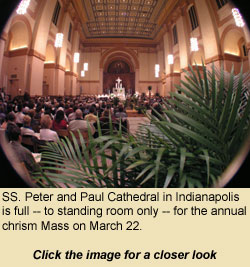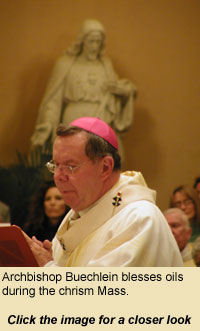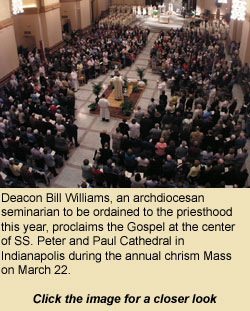Archdiocesan chrism Mass highlights unity
while connecting local Church to its past
Story and photos by Brandon A. Evans
 See more pictures and download an audio file of the archbishop's homily by clicking here
See more pictures and download an audio file of the archbishop's homily by clicking here
The annual archdiocesan chrism Mass, held this year on March 22 at SS. Peter and Paul Cathedral in Indianapolis, is a sign of unity and communion within the local Church.
It is one of the few times during the year when the Church in central and southern Indiana is most fully manifested—the archbishop, his priests, ministers and laity from every corner of the archdiocese are gathered in the cathedral.
It is also the evening that Archbishop Daniel M. Buechlein blesses oils for sacramental use throughout the archdiocese in the coming year.
Representatives from each parish receive the holy oils to take back to their parishes, where they will eventually grace the heads of the newly baptized and will be used to impart a final grace to those leaving this world.
But more than a sign of the unity we share now, Archbishop Buechlein chose to stress another form of communion during the chrism Mass—communion with the Church of the past.
Preaching to an overflowing cathedral bathed in warm light, the archbishop turned the thoughts of those present back to 1834.
That was the year that Bishop Simon Bruté became the first bishop of the new Diocese of Vincennes, which covered all of Indiana and eastern Illinois.
 The local Church at that time was made up of one bishop, two priests and a few Catholic households over more than 52,000 square miles.
The local Church at that time was made up of one bishop, two priests and a few Catholic households over more than 52,000 square miles.
“We come from humble beginnings,” Archbishop Buechlein said. “Our first Cathedral—in Vincennes—was only 100 feet in length. The walls were without plaster. Burlap was used to cover the windows. There was no heat.”
In that sparse place, Bishop Bruté hung a single, eight-inch picture of St. Francis Xavier—the patron of the archdiocese—for the people who visited the Cathedral.
Still, the poverty of the time made little difference, the archbishop said.
“Our one, holy, catholic and apostolic Church took root there in all simplicity,” he said. “In the humble beginning on the banks of the Wabash [River] here in Indiana, we inherited our Catholic faith.”
It is good for us, he said, to remember that the unity that Catholics share today is not just with each other, but with their ancestors as well.
“The unity of our faith reaches back to our past—indeed back to Christ and the apostolic age,” he said. “From there, our Catholic heritage came by way of Europe to Indiana and was especially gifted by courageous pioneers.”
The archbishop offered special words of praise for Bishop Bruté and Blessed Mother Theodore Gúerin, the foundress of the Sisters of Providence.
He also turned special attention to the nearly 100 priests of the archdiocese who had gathered at the Mass to publicly renew their promises of the priesthood.
 “Brother priests,” the archbishop said, “as we renew our ordination promises tonight, we do so as a communio—a presbyteral college. And it’s fruitful for us to remember also that at ordination we were not only united to the priests of our archdiocese in our day. We can trace our communion back to the apostolic era, and we are in privileged communion with our first bishop and the 1834 small presbyterate of two priests.”
“Brother priests,” the archbishop said, “as we renew our ordination promises tonight, we do so as a communio—a presbyteral college. And it’s fruitful for us to remember also that at ordination we were not only united to the priests of our archdiocese in our day. We can trace our communion back to the apostolic era, and we are in privileged communion with our first bishop and the 1834 small presbyterate of two priests.”
The tradition of using holy oils is also something that marks us to our past.
“This chrism Mass and Holy Week point us to the roots of our Church and to the treasure of the sacraments,” Archbishop Buechlein said. “The blessing of the holy oils calls us to deeper faith in the reality they sign and seal: in baptism, in confirmation, in Holy Orders, in the anointing of the sick.
“Let us pray for our unity with sincere and very grateful and joyful hearts,” he said. “Let’s pray with the humble spirit of Bishop Bruté. Let’s pray with the holy determination of Blessed Mother Theodore. Surely, they join us in our mission still.” †
Want more information about the chrism Mass? Click here


